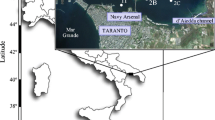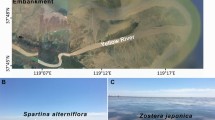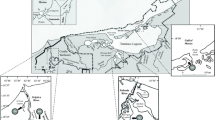Abstract
The food web of two intertidal seagrass (Zostera marina and Zostera noltii) beds that may be influenced by the seasonal variation in food source abundance was studied in winter and in summer with δ13C and δ15N analysis. In spite of high relative variation of abundance of main primary producers at the two sites, the food web did not vary between winter and summer. The δ13C range of primary producers was wide. Zostera leaves, the most 13C-enriched source, were not consumed directly by grazers. Deposit and filter feeders have a similar δ13C and could use a mix of suspended and sedimented organic particulate matter, largely composed of detritus from macroalgae to seagrass. This trophic pathway allows the local incorporation of the high biomass produced by seagrasses. The wide δ15N range of predators was linked either to a large variety from omnivore to carnivore predators or to the also wide ranges of δ15N of primary consumers.






Similar content being viewed by others
References
Baeta A, Valiela I, Rossi F, Pinto R, Richard P, Niquil N, Marques J (2009) Eutrophication and trophic structure in response to the presence of the eelgrass Zostera noltii. Mar Biol 156:2107–2120
Bode A, Alvarez-Ossorio MT, Varela M (2006) Phytoplankton and macrophyte contributions to littoral food webs in the Galician upwelling estimated from stable isotopes. Mar Ecol Prog Ser 318:89–102
Dauby P, Poulicek M (1995) Methods for removing epiphytes from seagrasses: SEM observations on treated leaves. Aquat Bot 52:217–228
DeNiro MJ, Epstein S (1978) Influence of diet on the distribution of carbon isotopes in animals. Geochim Cosmochim Acta 42:495–506
Duarte CM (2002) The future of seagrass meadows. Environ Conser 29:192–206
Duarte CM, Cebrian J (1996) The fate of marine autotrophic production. Limnol Oceanogr 41:1758–1766
Fredriksen S (2003) Food web studies in a Norwegian kelp forest based on stable isotope (δ13C and δ15N) analysis. Mar Ecol Prog Ser 260:71–81
Granado I, Caballero P (2001) Feeding rates of Littorina striata and Osilinus atratus in relation to nutritional quality and chemical defences of seaweeds. Mar Biol 138:1213–1224
Harrison PG (1982) Control of microbial growth and of amphipod grazing by water-soluble compounds from leaves of Zostera marina. Mar Biol 67:225–230
Heck K, Able K, Roman C, Fahay M (1995) Composition, abundance, biomass, and production of macro fauna in a New England estuary: comparisons among eelgrass meadows and other nursery habitats. Estuar Coasts 18:379–389
Hemminga MA, Mateo MA (1996) Stable carbon isotopes in seagrasses: variability in ratios and use in ecological studies. Mar Ecol Prog Ser 140:285–298
Hily C, Connan S, Raffin C, Wyllie-Echeverria S (2004) In vitro experimental assessment of the grazing pressure of two gastropods on Zostera marina L. ephiphytic algae. Aquat Bot 78:183–195
Hoshika A, Sarker MJ, Ishida S, Mishima Y, Takai N (2006) Food web analysis of an eelgrass (Zostera marina L.) meadow and neighbouring sites in Mitsukushi Bay (Seto Inland Sea, Japan) using carbon and nitrogen stable isotope ratios. Aquat Bot 85:191–197
Jaschinski S, Brepohl DC, Sommer U (2008) Carbon sources and trophic structure in an eelgrass Zostera marina bed, based on stable isotope and fatty acid analyses. Mar Ecol Prog Ser 358:103–114
Jephson T, Nystrom P, Moksnes P-O, Baden SP (2008) Trophic interactions in Zostera marina beds along the Swedish coast. Mar Ecol Prog Ser 369:63–76
Jorgensen CB (1996) Bivalve filter feeding revisited. Mar Ecol Prog Ser 142:287–302
Kaehler S, Pakhomov EA, McQuaid CD (2000) Trophic structure of the marine food web at the prince Edward islands (southern ocean) determined by δ13C and δ15N analysis. Mar Ecol Prog Ser 208:13–20
Kang C-K, Choy E, Son Y, Lee J-Y, Kim J, Kim Y, Lee K-S (2008) Food web structure of a restored macro algal bed in the eastern Korean peninsula determined by C and N stable isotope analyses. Mar Biol 153:1181–1198
Kharlamenko VI, Kiyashko SI, Imbs AB, Vyshkvartzev DI (2001) Identification of food sources of invertebrates from the seagrass Zostera marina community using carbon and sulphur stable isotope ratio and fatty acid analyses. Mar Ecol Prog Ser 220:103–117
Kiyashko SI, Chernyaev MG, Rodionov IA (1997) Mixotrophy in shallow-water bivalve molluscs with bacterial endo symbionts: data on stable carbon isotope ratios. Russ J Aquat Ecol 6:53–57
Kock EW, Ackerman JD, Verduin J, van Keulen M (2006) Fluid dynamics in seagrass ecology—from molecules to ecosystems. In: Larkum AWD, Orth RJ, Duarte CM (eds) Seagrasses: biology, ecology and conservation. Springer, Dordrecht, pp 193–225
Lebreton B, Richard P, Galois R, Radenac G, Pfléger C, Guillou G, Mornet F, Blanchard GF (2011) Trophic importance of diatoms in an intertidal Zostera noltii seagrass bed: evidence from stable isotope and fatty acid analyses. Estuar Coast Shelf Sci 92:140–153
Lepoint G, Dauby P, Gobert S (2004) Application of C and N stable isotopes to ecological and environmental studies in seagrass ecosystems. Mar Pollut Bull 49:887–891
McConnaughey T, McRoy CP (1979) δ13C label identifies eelgrass (Zostera marina) carbon in an alaskan estuarine food web. Mar Biol 53:263–269
McCutchan JHJ, Lewis WMJ, Kendall C, McGrath CC (2003) Variation in trophic shift for stable isotope ratios of carbon, nitrogen, and sulphur. Oikos 102:378–390
McRoy CP, McMillan C (1977) Production ecology and physiology of seagrasses. In: McRoy CP, Helfferich C (eds) Seagrass ecosystems: a scientific perspective. Dekker, New York, pp 53–81
Moksnes P-O, Gullstrom M, Tryman K, Baden S (2008) Trophic cascades in a temperate seagrass community. Oikos 117:763–777
Ouisse V, Migné A, Davoult D (2010) Seasonal variations of community production, respiration and biomass of different primary producers in an intertidal Zostera noltii bed (western English Channel, France). Hydrobiologia 649:3–11
Ouisse V, Riera P, Migne A, Leroux C, Davoult D (2011) Freshwater seepages and ephemeral macroalgae proliferation in an intertidal bay: I effect on benthic community structure and food web. Estuar Coast Shelf Sci 91:272–281
Parnell AC, Inger R, Bearhop S, Jackson AL (2010) Source partitioning using stable isotopes: coping with too much variation. PLoS ONE 5:e9672
Rau GH, Mearns AJ, Young DR, Olson RJ, Schafer HA, Kaplan IR (1983) Animals δ13C correlates with trophic level in pelagic food webs. Ecology 64:1314–1318
Riera P, Hubas C (2003) Trophic ecology of nematodes from various microhabitats of the Roscoff Aber Bay (France): importance of stranded macroalgae evidenced through δ13C and δ15N. Mar Ecol Prog Ser 260:151–159
Riera P, Escaravage C, Leroux C (2009) Trophic ecology of the rocky shore community associated with the Ascophyllum nodosum zone (Roscoff, France): a δ13C versus δ15N investigation. Estuar Coast Shelf Sci 81:143–148
Schaal G, Riera P, Leroux C (2008) Trophic coupling between two adjacent benthic food webs within a man-made intertidal area: a stable isotopes evidence. Estuar Coast Shelf Sci 77:523–534
Schaal G, Riera P, Leroux C (2010) Trophic ecology in a northern Brittany (Batz Island, France) kelp (Laminaria digitata) forest, as investigated through stable isotopes and chemical assays. J Sea Res 63:24–35
Stephenson RL, Tan FC, Mann KH (1986) Use of stable carbon isotope ratios to compare plant material and potential consumers in a seagrass bed and a kelp bed in Nova Scotia, Canada. Mar Ecol Prog Ser 30:1–7
Vander Zanden MJ, Rasmussen JB (2001) Variation in δ15N and δ13C trophic fractionation: implications for aquatic food web studies. Limnol Oceanogr 46:2061–2066
Vanderklift MA, Ponsard S (2003) Source of variation in consumer-diet δ15N enrichment: a meta-analysis. Oecologia 136:169–182
Acknowledgments
This study forms part of the Ph.D. thesis of V. Ouisse and was financially supported by the “Ministère de l’Enseignement Supérieur et de la Recherche”. The authors would like to thank G. Schaal for his knowledge of isotope stable analyses, the Service Mer et Observation, R. Michel and L. Oppliger for their help in field sampling. We also would like to thank the two anonymous referees, whose comments greatly contributed to the improvement of the manuscript.
Author information
Authors and Affiliations
Corresponding author
Additional information
Communicated by U. Sommer.
Rights and permissions
About this article
Cite this article
Ouisse, V., Riera, P., Migné, A. et al. Food web analysis in intertidal Zostera marina and Zostera noltii communities in winter and summer. Mar Biol 159, 165–175 (2012). https://doi.org/10.1007/s00227-011-1796-2
Received:
Accepted:
Published:
Issue Date:
DOI: https://doi.org/10.1007/s00227-011-1796-2




